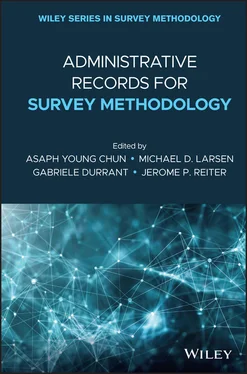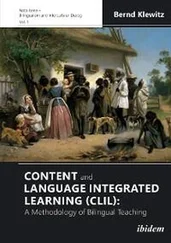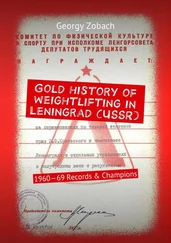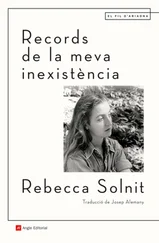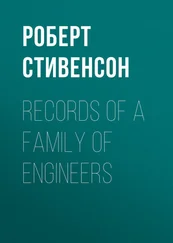15 Currie, R. and Fortin, S. (2015). Social statistics matter: history of the Canadian Research Data Center Network. Canadian Research Data Centre Network. http://rdc-cdr.ca/sites/default/files/social-statistics-matter-crdcn-history.pdf(accessed 05 August 2020).
16 Dalenius, T. and Reiss, S.P. (1982). Data-swapping: a technique for disclosure control. Journal of Statistical Planning and Inference 6 (1): 73–85. https://doi.org/10.1016/0378-3758(82)90058-1.
17 Deang, L.P. and Davies, P.S. (2009). Access restrictions and confidentiality protections in the Health and Retirement Study. No. 2009–01, U.S. Social Security Administration. https://www.ssa.gov/policy/docs/rsnotes/rsn2009-01.html.
18 DeSalvo, B., Limehouse, F.F., and Klimek, S.D. (2016). Documenting the business register and related economic business data. Working Papers 16–17. Center for Economic Studies. U.S. Census Bureau. https://ideas.repec.org/p/cen/wpaper/16-17.html.
19 Duncan, G.T., Jabine, T.B., and de Wolf, V.A. (eds.); Panel on Confidentiality and Data Access, Committee on National Statistics, Commission on Behavioral and Social Sciences and Education, National Research Council and the Social Science Research Council (1993). Private Lives and Public Policies: Confidentiality and Accessibility of Government Statistics. Washington, DC: National Academy of Sciences.
20 Duncan, G.T., Elliot, M., and Salazar-González, J.J. (2011). Statistical Confidentiality: Principles and Practice, Statistics for Social and Behavioral Sciences. New York: Springer-Verlag.
21 Dwork, C. (2006). Differential privacy. In: Automata, Languages and Programming, Lecture Notes in Computer Science, vol. 4052 (eds. M. Bugliesi, B. Preneel, V. Sassone and I. Wegener), 1–12. Berlin, Heidelberg: Springer Berlin Heidelberg. http://link.springer.com/10.1007/11787006_1.
22 Dwork, C. and Roth, A. (2014). The algorithmic foundations of differential privacy. Foundations and Trends® in Theoretical Computer Science 9 (3–4): 211–407. https://doi.org/10.1561/0400000042.
23 Dwork, C., McSherry, F., Nissim, K., Smith, A. (2006). Calibrating noise to sensitivity in private data analysis. In: Proceedings of the 3rd Theory of Cryptography Conference, pp. 265–284.
24 Dwork, C., Smith, A., Steinke, T., Ullman, T. (2017). Exposed! A Survey of Attacks on Private Data. Annual Review of Statistics and Its Application, 4 (1): 61–84.
25 Evans, T., Zayatz, L., and Slanta, J. (1998). Using noise for disclosure limitation of establishment tabular data. Journal of Official Statistics 14 (4): 537–551.
26 FCSM (2005). Report on statistical disclosure limitation methodology. Working Paper 22 (second version, 2005). Federal Committee on Statistical Methodology. https://s3.amazonaws.com/sitesusa/wp-content/uploads/sites/242/2014/04/spwp22.pdf.
27 Fellegi, I.P. (1972). On the question of statistical confidentiality. Journal of the American Statistical Association 67 (337): 7–18.
28 Fellegi, I.P. and Sunter, A.B. (1969). A theory for record linkage. Journal of the American Statistical Association 64 (328): 1183–1210. https://doi.org/10.1080/01621459.1969.10501049.
29 Fienberg, S.E. (2005). Confidentiality and disclosure limitation. In: Encyclopedia of Social Measurement (ed. K. Kempf-Leonard), 463–469. New York, NY: Elsevier.
30 Gittings, R. (2009). Essays in labor economics and synthetic data methods. PhD thesis. Cornell University, Ithaca, NY, USA. https://ecommons.cornell.edu/handle/1813/14039.
31 Gittings, R.K. and Schmutte, I.M. (2016). Getting handcuffs on an octopus: minimum wages, employment, and turnover. ILR Review 69 (5): 1133–1170. https://doi.org/10.1177/0019793915623519.
32 Holan, S.H., Toth, D., Ferreira, M.A.R., and Karr, A.F. (2010). Bayesian multiscale multiple imputation with implications for data confidentiality. Journal of the American Statistical Association 105 (490): 564–577. https://doi.org/10.1198/jasa.2009.ap08629.
33 Hyatt, H., McEntarfer, E., McKinney, K., et al. (2014). JOB-TO-JOB (J2J) flows: new labor market statistics from linked employer-employee data. Working Papers 14–34. Center for Economic Studies. U.S. Census Bureau. https://ideas.repec.org/p/cen/wpaper/14-34.html.
34 Institute for Employment Research (2016). Job submission application (JoSuA) at the Research Data Centre of the Federal Employment Agency: user manual. https://josua.iab.de/gui/manual.pdf(accessed 05 August 2020).
35 Karp, P. (2016). Census controversy shows ABS ‘needs to do better’, says Statistical Society. The Guardian (9 August 2016). http://www.theguardian.com/australia-news/2016/aug/09/census-controversy-shows-abs-needs-to-do-better-says-statistical-society.
36 Karr, A.F., Lin, X., Sanil, A.P., and Reiter, J.P. (2005). Secure regression on distributed databases. Journal of Computational and Graphical Statistics 14 (2): 263–279. https://doi.org/10.1198/106186005X47714.
37 Karr, A.F., Lin, X., Sanil, A.P., and Reiter, J.P. (2006). Secure statistical analysis of distributed databases. In: Statistical Methods in Counterterrorism (eds. A.G. Wilson, G.D. Wilson and D.H. Olwell), 237–261. New York: Springer. http://link.springer.com/chapter/10.1007/0-387-35209-0_14.
38 Karr, A.F., Lin, X., Sanil, A.P., and Reiter, J.P. (2009). Privacy-preserving analysis of vertically partitioned data using secure matrix products. Journal of Official Statistics 25 (1): 125–138.
39 Kraus, R. (2013). Statistical Déjà vu: the national data center proposal of 1965 and its descendants. Journal of Privacy and Confidentiality 5 (1) : 1–37. https://doi.org/10.29012/jpc.v5i1.624Accessed online (01/19/2021) at https://journalprivacyconfidentiality.org/index.php/jpc/article/view/624.
40 Machanavajjhala, A., Kifer, D., Abowd, J.M. et al. (2008). Privacy: theory meets practice on the map. In: Proceedings of the International Conference on Data Engineering IEE, 277–286. https://doi.org/10.1109/ICDE.2008.4497436.
41 Massell, P.B. and Funk, J.M. (2007). Recent developments in the use of noise for protecting magnitude data tables: balancing to improve data quality and rounding that preserves protection. Proceedings of the 2007 FCSM Research Conference. Council of Professional Associations on Federal Statistics. Washington, DC, USA (5–7 November, 2007). https://nces.ed.gov/FCSM/pdf/2007FCSM_Massell-IX-B.pdf
42 Massell, P., Zayatz, L., and Funk, J. (2006). Protecting the confidentiality of survey tabular data by adding noise to the underlying microdata: application to the commodity flow survey. In: Privacy in Statistical Databases, Lecture Notes in Computer Science (eds. J. Domingo-Ferrer and L. Franconi), 304–317. Springer Berlin Heidelberg. https://doi.org/10.1007/11930242_26.
43 McKinney, K.L. and Vilhuber, L. (2011a). LEHD data documentation LEHD-Overview-S2008-rev1. Working Papers 11–43. Center for Economic Studies. U.S. Census Bureau. https://ideas.repec.org/p/cen/wpaper/11-43.html.
44 McKinney, K.L. and Vilhuber, L. (2011b). LEHD infrastructure files in the Census RDC: overview of S2004 snapshot. Working Papers 11–13. Center for Economic Studies. U.S. Census Bureau. https://ideas.repec.org/p/cen/wpaper/11-13.html.
45 National Institute on Aging and the National Institutes of Health (2017). Growing Older in America: The Health and Retirement Study. University of Michigan. http://hrsonline.isr.umich.edu/index.php?p=dbook.
46 O’Keefe, C.M., Westcott, M., Ickowicz, A., et al. (2013). Protecting confidentiality in statistical analysis outputs from a virtual data centre. Joint UNECE/Eurostat work session on statistical data confidentiality.
47 Raab, G.M., Dibben, C., and Burton, P. (2015). Running an analysis of combined data when the individual records cannot be combined: practical issues in secure computation. Joint UNECE/Eurostat work session on statistical data confidentiality. http://www1.unece.org/stat/platform/display/SDCWS15/Statistical+Data+Confidentiality+Work+Session+Oct+2015+Home.
Читать дальше
